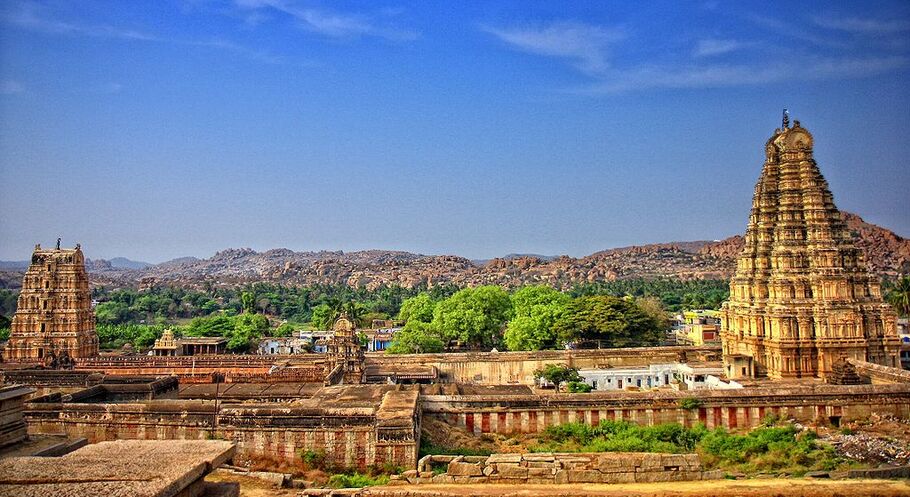
A date with history: Top 7 Unesco heritage sites in Karnataka
Karnataka has 3 Unesco heritage sites and 4 on the tentative list to get the tag. Here’s what you can hope to see

Are you a history buff? Does life carved out on stone by the master architects of yore mesmerize you? If you said “yes” to both, Karnataka is a must-visit state for you. Karnataka already houses three Unesco World Heritage sites of India’s coveted list of 40, and another four are on the waiting list.
We will give you some details about each site, and you can decide whether your next holiday destination could be the beautiful state once home to the mighty Vijaynagar Empire.
1. Hampi
The Unesco lists the “Group of Monuments at Hampi” as a world heritage site. These group of monuments are essentially the ruins of the mighty Vijaynagar Empire or Karnata Kingdom that ruled for over 300 years (1336–1646) across large parts of the Deccan. The ruins of the empire are spread across South India, but the most significant of them are at Hampi, which was the capital of Vijaynagar Empire for 200 years, from the beginning to 1565.
Located on the banks of the Tungabhadra, Hampi embodies the heyday of the Karnata Kingdom. By some accounts, it was the second largest city in the world at that time. It was also the first site in Karnataka to get the coveted Unesco World Heritage site tag in 1986. There are more than 500 monuments, temples, royal complexes, mandapas, pillared halls, water reservoirs, treasury buildings, and other captivating remains spread across the hilly tracts of northern Karnataka.
Feature: Where the stones speak to us – How Hampi conquered my mind and memory
Hampi is like an open museum, and there are more than a hundred locations to explore. One of the primary attractions of Hampi is the Virupaksha temple, dedicated to the chief deity of the empire. Other top places to visit in Hampi are the Vitthala Temple, Hemakuta Hill Temples, Hazara Rama Temple, Queen’s Bath, Elephant Stables, Lotus Mahal, Lakshmi Narasimha, Stepped Tank, Riverside Ruins, Hampi Bazaar, Archaeological Museum, residential areas, old aqueducts, canals, military barracks, and stables.
The best part is that few modern establishments have been allowed near the ruins, which gives them an authentic feel. We recommend that you spend at least two days in Hampi to explore everything at a leisurely pace.
How to reach: The nearest airport is at Bellary, about 60 km from Hampi. The nearest international airport is at Bengaluru, about 350 km away. The nearest railway station is at Hospet, around 13 km from Hampi.
Where to stay: It is best to stay at Hospet, which has better amenities. You can book a car or auto to explore Hampi.
2. Pattadakal-Badami-Aihole
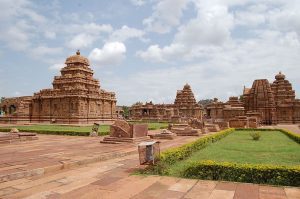
Remember reading about the Chalukya and Rashtrakuta dynasties in school history books? The Group of Monuments at Pattadakal, which received Unesco World Heritage site status in 1987, is all about the glories of the Chalukyas and Rashtrakutas. While the former ruled over large parts of southern, western, and central India between the sixth and 12th centuries, the latter stole the show for about 200 years, from the middle of the eighth century to the late tenth century.
Located on the banks of the Malprabha, this region was originally called Raktapura. The small village of Pattadakal houses a series of nine Hindu temples dedicated to Lord Shiva and a Jain temple that exhibits a blend of Dravidian and Indo-Aryan designs. The Hindu temples are some of the oldest in the country and are excellent examples of Badami Chalukya style of architecture. The Jain temple was built in the ninth century by the Rashtrakutas.
Also read: Western Railway revises Mumbai-Gandhinagar Vande Bharat Express travel time from Oct 5
Pattadakal is also famous as the “City of Crown Rubies,” as it used to be the holy city for the royal coronation of the Chalukyas. While in Pattadakal, do not miss the Virupaksha, Sangameshwara, Chandrasekhar, Mallikarjuna, Papanatha, Kashivishwanaath, and Galganath temples. The Hindu temples are famous for their exquisite sculptures, pillars, and facades carved with stories from the epics.
The total site is 23 km long, extending from Badami to Aihole, both of which are historically significant centres of Chalukya monuments. A classical dance festival is held in Pattadakal in January. You can club Pattadakal with Aihole and Badami in a three-day trip from Bangalore. And don’t forget to dig into some scrumptious local food when you are there.
Watch: Mamallapuram beats Taj Mahal as top draw for foreign tourists
How to reach: The nearest airport is at Belgaum, about 180 km from Pattadakal. Badami is the nearest railway station, located about 22 km from Pattadakal.
Where to stay: There are several hotels and resorts in and around Pattadakal, including Badami and Bagalkot
3. Western Ghats or Sahyadri Mountains

Did you even know that the Sahyadri Mountains or the Western Ghats are a Unesco World Heritage site? Well, of course, this is not a historical or architectural site as such. But since this 1,600-km range running parallel to India’s western coast is older than the Himalayas and has seen the rise and fall of so many empires, why not take some time to appreciate their beauty?
Passing through Kerala, Tamil Nadu, Karnataka, Goa, Maharashtra, and Gujarat, the Western Ghats cover an area of 160,000 sq km in all. The Unesco World Heritage Committee added the Western Ghats as a world heritage site in 2012, comprising 39 national parks, wildlife sanctuaries, and reserve forests. Ten of these are in Karnataka. Also, the Sahyadri is one of the ten hottest biodiversity hotspots in the world.
4. Monuments and Forts of the Deccan Sultanate (Bidar, Bijapur, and Gulbarga)
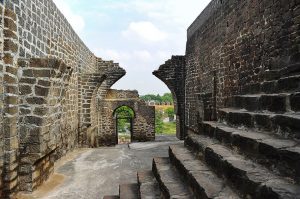
The “Monuments of the Deccan Sultanate,” spread across Gulbarga, Bidar, Bijapur, and Hyderabad, are collectively on the Unesco World Heritage tentative list. These medieval fortifications and walled cities are excellent examples of the amalgamation of Islamic architecture with prevalent southern Indian architecture.
Gulbarga was the first capital (1347–1425) of the Bahmani kingdom (1347–1527), arch enemies of the Vijaynagar empire. The monuments at Gulbarga comprise the Gulbarga fort (in picture), Great Mosque, and the Gumbad complex with seven tombs.
Bidar, which was the second capital (1425–1527), houses the Bidar Fort, the Madrasa Mahmud Gawan, the Bahamani tombs at Ashtur, and the Barid Shahi tombs.
Also read: 1.62 crore tourists visited J-K this year so far, highest in 75 years: Official
Bijapur came into the picture much later, when the Bahmani Sultanate broke up into several pieces. The 80 Bijapur monuments comprise fortifications, gates, tanks, mosques, tombs, and palaces. Gol Gumbaj is the most notable monument in this group. It has the world’s second-largest dome, second only to St Peter’s Basilica in Rome. The 1700-sqm inner chamber is the world’s biggest single chamber.
How to reach: All three locations are easily accessible from Hyderabad
Where to stay: Decent accommodation is available in all three
5. Monuments of Srirangapatna
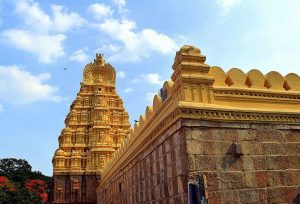
Srirangapatna, a town near Mysore, houses some of the most marvellous architectural wonders of the Vijaynagar and Hoysala kingdoms. It is an island in the Cauvery and takes its name from its celebrated Ranganathaswamy temple. This temple, dedicated to Lord Vishnu, is one of the largest in Karnataka.
Srirangapatna was once the capital of Mysore state and is now on the Unesco World Heritage site tentative list. Some of the must-visit locations in the island town are Daria Daulat Bagh, Srirangapatna Fort, Gumbaz of Tipu Sultan, Jama Masjid, and Ranganathittu Bird Sanctuary.
How to reach: The nearest airport and railway station are at Mysore, about 14 km away. You can take a taxi to Srirangapatna.
Where to stay: You can stay in Mysore and make a day trip to Srirangapatna. There is limited accommodation in the town.
6. Hoysala temples of Belur, Halebidu, and Somnathapura
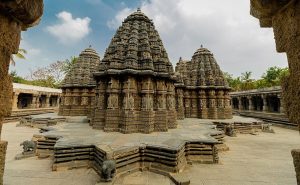
This site has also been on the Unesco World Heritage list since 2014. Some more structures were added to the list in 2022-23. These temples are wonderful gifts of the Hoysalas, the dynasty that ruled most of what is now Karnataka from the 10th to the 14th centuries.
Located in Karnataka’s Hassan district, some of the must-visit locations of this site are the Chennakesava (1117 CE) and Hoyasaleshwara temples (1121 AD), known for their star-shaped platforms, intricate carvings, and polished sculptures. Depictions from Hindu mythology, figures of animals, birds, and dancing figures adorn the temple walls.
Also read: Looking for offbeat hill stations? Here are 6 of the best in Andhra
More than hundred such Hoysala temples survive in Karnataka. But the ones at Somnathapura, Belur, and Halebidu are the most iconic. Chennakesava is possibly the largest Hoysala temple, and it is still intact.
How to reach: The nearest airport is at Bengaluru, about 222 km away. Hassan is the nearest railhead, about 40 km away.
Where to stay: There is decent accommodation in and around Belur and Halebidu.
7. Hire Benakal, Megalithic Site (2021)
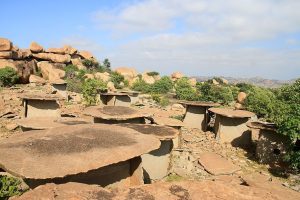
Hire Benakal (or Hirebenakal) is a prehistoric site in Karnataka dating back to 800 BCE. Located in Koppal district, around 10 km from Gangavati and 35 km from Hospet, the site contains around 400 megalithic funerary monuments from the Neolithic period to the Iron Age. In Kannada, they are called “moryar guḍḍa” (or “the hill of the Moryas”). Hirebenakal is possibly the largest necropolis (ancient burial ground) among the 2000-odd megalithic sites in southern India, most of them in Karnataka. Hirebenakal is the latest site in Karnataka to be recommended for a Unesco World Heritage tag.
How to reach: Since the site is 35 km from Hospet, you can club this trip with Hampi.
Where to stay: Hospet has decent accommodation.


